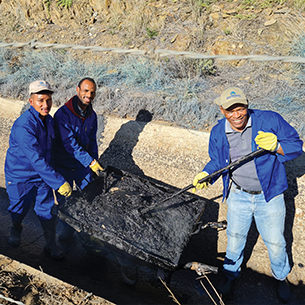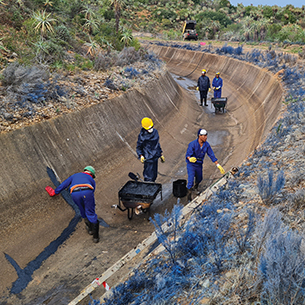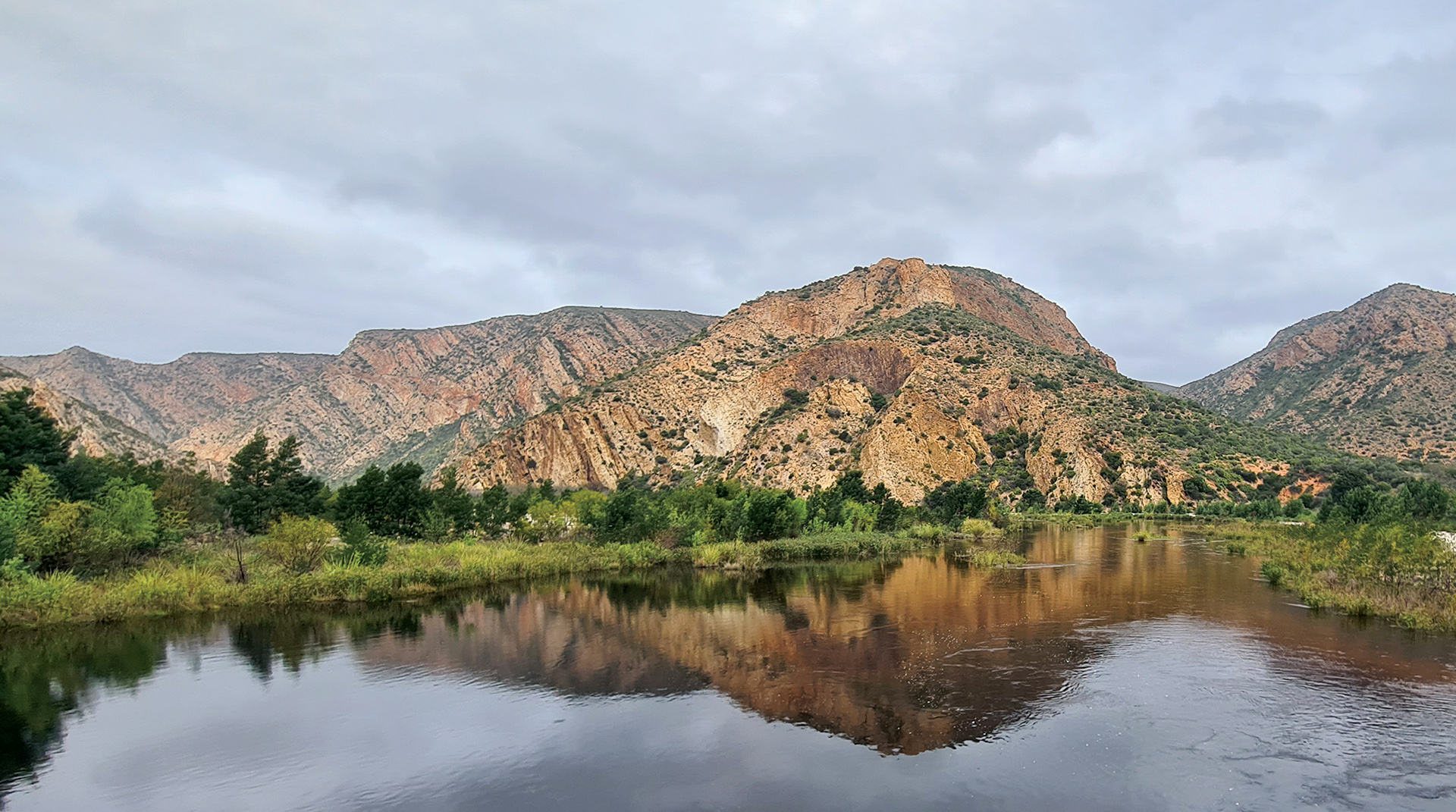
Doodsklip at the head of the Kouga Dam | Image: Jaco Malan
How does one address a water community in a year that demanded every ounce of strength and the will to survive?
Our corridors are silent, a generator humming in the background. The silence speaks to the current economic conditions that have forced the Board to scale down operationally in keeping with the realities of our valley. The generator compensates for the lack of power and productivity while our country’s electricity giant struggles to keep the lights on.
During the 2021/22 water year, operationally speaking, outstanding work was once again carried out on our scheme. Although the completed work represented good value for money, it is necessary to give our agricultural community time to recover after a few challenging years. Over the next few months, there will be a strong focus on developing detailed business plans that will determine the long-term outlook for maintenance work on the system.
This year, we fought a losing battle for a water allocation that would allow agricultural users some breathing room after five years of extremely high water restrictions. Kouga Dam’s water level has, since July 2021, slowly recovered from 3.89% to a hopeful 15.37% at the end of July 2022. However, the inadequate and reckless water management in the Nelson Mandela Bay metro, at the expense of disciplined agricultural users, remains a concern.
For this reason, it is important to sit around a table and play a meaningful role in discussions as a modern organisation that is perceived to be transformed at all levels. We must remain relevant as a water entity in a changing environment. The Board is already at an advanced stage in the process of transforming into a Water Users Association (WUA) and this should take place early next year.
The success of the Board is entirely dependent on our dedicated team who are passionate about their work and tackle any task with enthusiasm. Every individual in the management team is an independent thinker and is encouraged to be innovative in their problem-solving approach. Our new addition, Jonathan, is a specialist in dry-land rehabilitation. The need for a holistic approach to our canal system justifies his appointment.
The implementation of the Department of Forestry, Fisheries and the Environment projects was a challenge during 2021/22. Processes within the department and available budgets had an enormous impact on the contracts that could be signed and funds that were spent. In keeping with the downscaling of activities, personnel were reduced from 32 to 11.
It is with great sadness that we remember Tertius Meyer, our chairman, who lost his battle with cancer in October 2021. Tertius had been on the board since 2003, representing the Hankey section, and was elected chairman following Merwe du Preez’s passing in 2011. During his term, Tertius earned respect as a good leader with vision and integrity. He was taken from us too soon and his contribution will be missed.
Pietie Ferreira of Wagondrift has been co-opted in his place and Marthinus Colesky has led the Board in the interim. The rest of the board members are Khaya Katoo, SG Ferreira and Manus Meyer.
These individuals give unselfishly of their time and have built up an exceptional knowledge of water issues. Their impartial leadership and inputs are absolutely priceless in ensuring successful outcomes.

The year 2021 came with abnormal challenges. There is a certain assumption that if you have taken care of a citrus crop and done everything in your power to ensure an optimal yield, the appropriate yield will be realised. This year, however, we were powerless against external factors that determine our income and continued existence. Although I am speaking as a citrus farmer, the same applies to all farming activities in our valley.
The biggest concern is no longer how to survive on a 15% water quota available from the scheme. There are bigger considerations, such as the enormous fuel price increase during the year, caused by the war in Ukraine. The unpredictable power supply has had an impact on farming activities as well as supply chain operations. The economic effects of COVID-19 are still being felt across the global logistics system, while overseas countries are protecting their own producers, whether we like it or not. It leaves us feeling defeated this year.
The after-effects that Eskom is experiencing from years of corruption and neglect of maintenance are now being felt by all South Africans, but the enormous cost implications of an economy that grinds to a halt with each wave of power failures is also hitting every pocket, impoverishing our country and increasing unemployment. Therefore, the provision of water to our agricultural water users and municipalities must never be allowed to deteriorate into a similar state of total collapse and lack of funds.
Funds entrusted to Gamtoos Irrigation Board by our water users must be managed with transparency and wisdom, and we must strive to maintain the provision capacity of our scheme as effectively as possible through innovative ideas and regular maintenance.
The scheme is well managed. The Board is enjoying the fruits of the intensive maintenance work carried out over the last few years. The opportunity to do so arose during the years of severe restrictions, as the scheme was more accessible. An average water loss of 7.5% in an open system is currently being recorded. The Board is visible in the Gamtoos Valley, and also in the broader communities, including government departments and other relevant platforms. To make a difference in our environment, we must be seen.
May 2022 deliver a few good surprises. We need it in a punch-drunk valley.
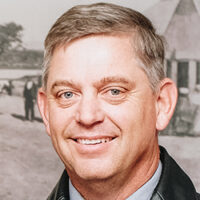
In April, Jonathan Snyders moved over from the Working for Wetlands project to manage dry-land rehabilitation around the cement structures on our scheme. Aside from his experience in this area, Jonathan’s knowledge of concrete will allow him to make a valuable contribution.
During the previous financial year, we enrolled 10 local students in our plant propagation course. Nine successfully completed the course and two have joined the Board in different capacities.
At the beginning of the year, we identified a need for a fitter and turner in our workshop. A matric learner from Daniel Pienaar High School, Jacques Erasmus, was recruited to complete his apprenticeship.
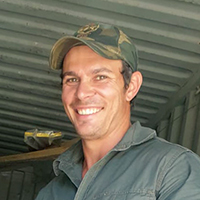
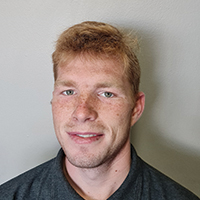
Water Restrictions 2021/22
This was the sixth consecutive year that water users in our scheme had their quota restricted.

New record low
Kouga Dam level at 22 July 2021: 3.89%
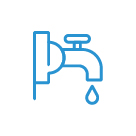
Water from Kouga Dam during full-quota year
Agricultural users: 60.188 million m³
Municipalities (Hankey, Patensie, Nelson Mandela Bay): 24 million m³
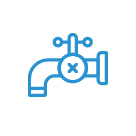
2021/22 water restrictions
Agricultural users: 85%
Kouga Municipality: 50%
(The rest of the sources in the Algoa System were restricted by 40% and the Metro was restricted by 85% from Loerie Dam.)

Impact on agriculture
The profile of land usage has changed dramatically to adjust to the scarcity of water. Innovative plans are being made and ground water was exploited at scale. This expensive process has influenced water users’ reserves.
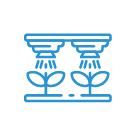
Water rationing
It is operationally difficult to manage a 15% allocation. The system was operated at low volumes and water made available five days a week. This led to high water losses:
• Average recorded: 30.7%
• Volume of loss: 5.4 million m³ (9% in a full-quota year)
By 30 June 2022, agricultural water users had used 90.3% of the 15% quota.
| Year | Kouga Dam level at 30 June | Allocation for water year |
| 2022 | 15.37% | 20% |
| 2021 | 4.19% | 15% |
| 2020 | 7.11% | 20% |
| 2019 | 44.98% | 85% |
| 2018 | 7.89% | 40% |
| 2017 | 18.65% | 40% |
| 2016 | 68.03% | 100% |
| 2015 | 100.27% | 100% |
| 2014 | 88.97% | 100% |
| 2013 | 87.18% | 100% |
| 2012 | 87.96% | 100% |
| 2011 | 100.93% | 100% |
| 2010 | 34.42% | 40% |
Operational Health
2022 Dry Period
An enormous amount of work was done on our scheme during the two-week dry period in 2022.
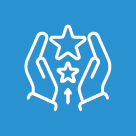
Highlights
• Involved 20 contractors, each with 10 workers.
• Provided first aid, health and safety, as well as confined spaces training. This ploughs knowledge back into our communities.
• Working for Water personnel were assigned to manage parts of the project.

Work completed
• Komdomo Siphon (A7): Dewatered, cleaned, inspected.
• A1 Boxed Tunnel: Cleaned, inspected, repaired.
• H. Moolman Siphon (A95): Dewatered, cleaned, inspected.
• Bodker 1 Siphon (A84): Dewatered, cleaned, replaced mechanical seal.
• Wagondrift 1 Siphon: Installed mechanical seal.
• Tweeling and Patensie Siphon: Installed rock traps.
• Main Canal (Sections 80-85): Cleaned, repaired with bitu-putty and bitu-plastic.
• Main Canal downstream of Buffelshoek Siphon (A86-104): Cleaned, repaired with bitu-putty and bitu-plastic.
• Main Canal (107): Special maintenance on remaining 480m section.
• Main Canal: General maintenance of remaining sections.
• Muller Dam (D Balancing Dam) outlet works: Installed water seal at construction joint inside the chamber.
• B Canal: Cleaned, repaired almost entire canal with bitu-putty and bitu-plastic.
• General maintenance of all other branch canals.
• General maintenance of all automatic sluice gates.

Daily tasks
• Managing vegetation and weeds along the canal system.
• Dry land rehabilitation at various places on the scheme.
• Maintaining system and repairing leaks and structural failures.
• Managing the water supply.
The Board is finalising a new computer program for the management of the water system. The aim is to focus on the needs of the scheme and Gamtoos Valley water users. This program will operate next year in parallel with the WAS program.
Financial Health
Financial statements
During the 2021/22 year, the Board:
• spent significantly more on scheme maintenance
• R9 million on consumable stock and consultants (vs R5.5 million in 2020/21)
• saved on fixed expenses such as personnel and administration
| At a glance | 2021/22 | Allocation for water year |
| Total reserves | R30 million | R29 million |
| Water tax collected | R27.5 million | R25.1 million |
| % of income from water tax | 72.7% | 61.7% |
| Income subsidised by Working for Water | 9.5% | 13% |
The Board has no long-term debt.
Budget 2022/23
• Total budget: R36 585 800
• Water tax: 67.7% of the total budget (2020/21: 68.9%)
• Working for Water income subsidises the budget by 8.2% (2020/21: 8.3%). Note that less and less confidence is being placed in the commission from this income.
Water tariffs 2022/23
• No increase is recommended.
There is empathy for the tremendous pressure under which agricultural users are currently operating.
| Description | Previous Tariff | New Tariff |
| Water resource management charge (DWS) | R203.20 | R216.80 |
| Consumptive charge on main canal and Kouga Dam (DWS) | R325.60 | R358.40 |
| Gamtoos Irrigation Board water taxes | R3306.20 | R3259.80 |
| Total (basic of 80% or less of full allocation) | R3835.00 | R3835.00 |
| Grand Total (full allocation) | R4286.58 | R4286.58 |
Amounts do not include VAT.
Transformation
Gamtoos Irrigation Board was proclaimed an irrigation board in 1991 and is a statutory body under the National Water Act of 1956. The aim of the National Water Act of 1998 is, among others, that irrigation boards be transformed into water users associations (WUA).
The primary objective of a WUA is to manage water for a specific area at grassroots level. It takes the legal form of a co-operative association of individual water users who undertake water-related activities to the benefit of all.
During 2021/22, two adjacent catchment areas, including Baviaanskloof and the Kabeljous River, indicated that they want to form part of the new WUA. It is with great excitement that we include these water users. Gamtoos Irrigation Board in broader terms is responsible for the management of a state water scheme with its own complexities and cost structure, but there are water users in other areas who lack the expertise and administrative abilities to give answers and advice on daily water challenges. This larger entity should address all of these needs.

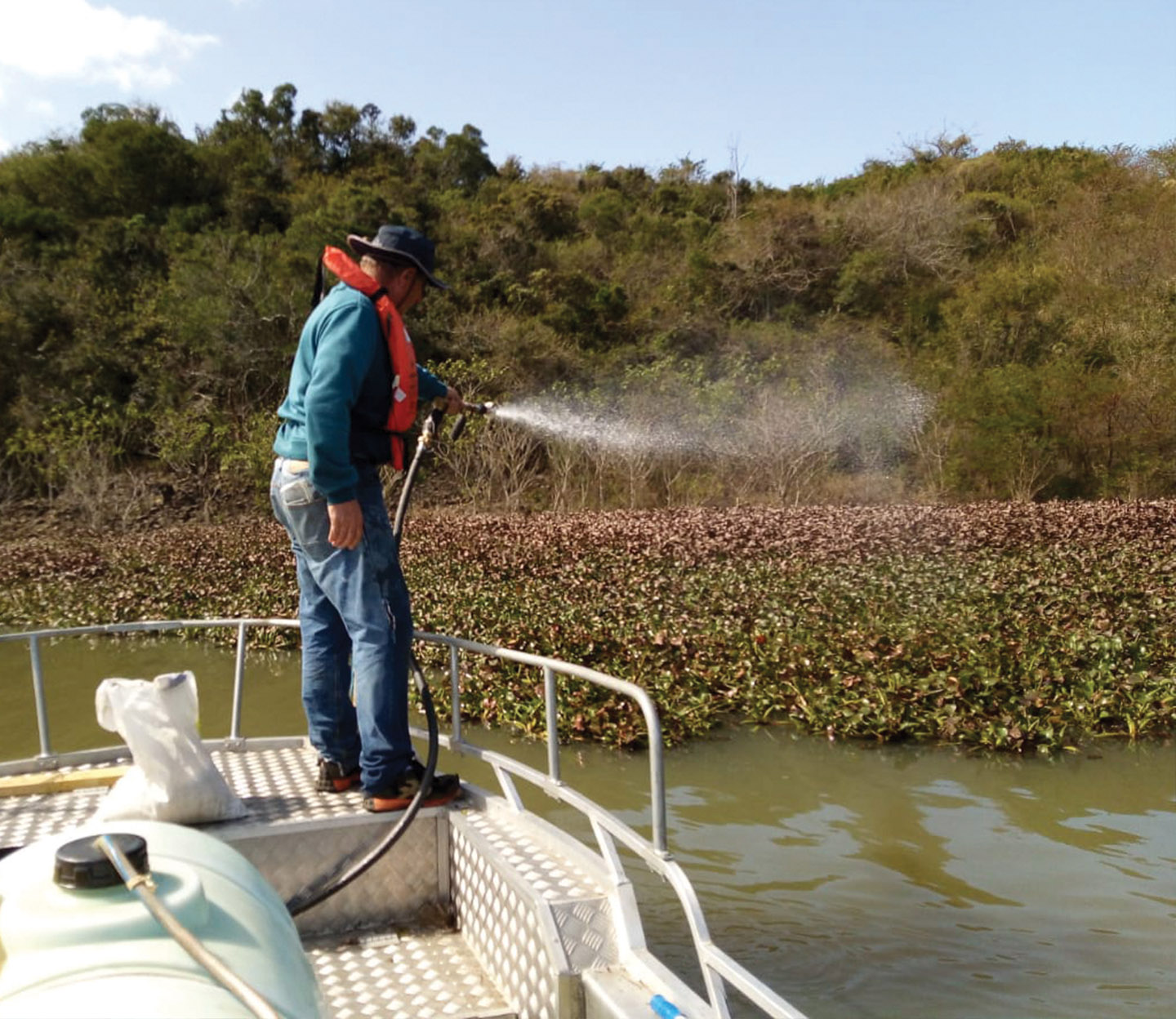
Working for Water
The Natural Resources Management projects of the Department of Forestry, Fisheries and the Environment (DFFE) represent a large portion of the Board’s activities. Although few of our full-time personnel are involved, the scope of the work cannot be underestimated.
The 2021/22 year was particularly challenging. Uncertainty about the future nature of the projects has obliged the Board to reduce personnel and cut fixed costs to the bone. A total of R45 million was spent.
The Road Ahead
For now, it is necessary to spend conservatively and gain clarity on the economic situation of our funders.
There is much work to be done and not enough time to do it. But we will not lose sight of the goal: Optimal water management with a system that is operated to the best of our and our water users’ abilities.
We don’t just hold ourselves accountable for the future of our water users and water sources. It is important to hold all stakeholders in our catchment area responsible for the water use and quality of our water sources that flow into Kouga Dam as well as the rivers in our area that flow to the sea.
Water quality and responsible quota use are issues that will influence the sustainability of our water sources, as well as the availability for agricultural use. For this reason, the involvement of the Board as a representative body on all platforms relating to water affairs is important.
For the sake of our agricultural and residential users, we can never say that any water issue is not our problem.
